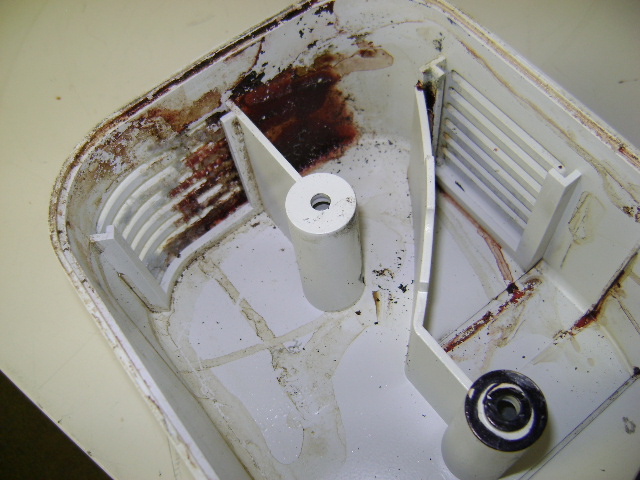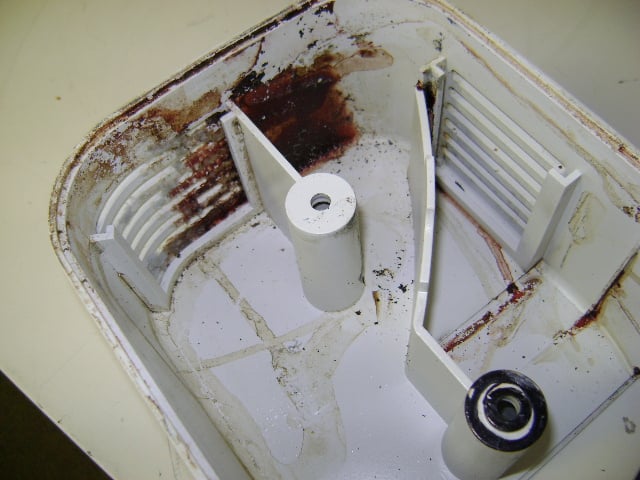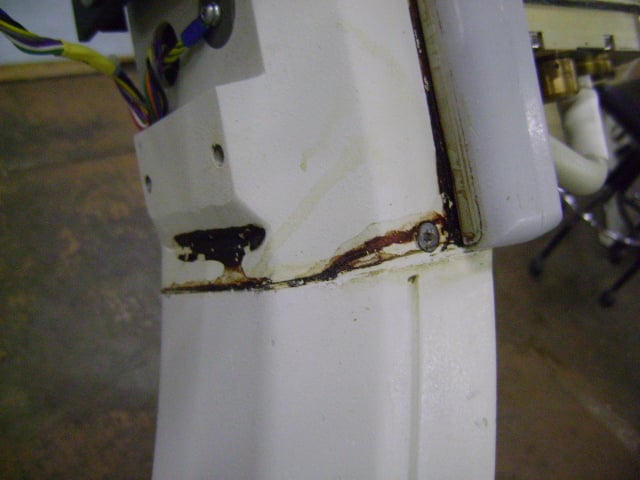
Updated: March 15, 2024 : 2 min read
C-Arm Decontamination Tips: Is Your C-Arm a Rolling Biohazard?
Any surgical C-arm worth its salt is a veteran of innumerable invasive procedures. In light of this, it’s not exactly breaking news to the doctors and technicians that work with them that this equipment can get messy sometimes. But plastic Image Intensifier (II) shields, fluid collection systems, and a regular wipe-down with hospital-grade disinfectant should keep things pretty clean, right? Wrong.
Keep reading to find out why C-arm decontamination matters and why typical measures may not be enough.
Why YOU Should Care About a Clean C-arm Inside AND Out
Here at Block Imaging we receive used C-arms from hospitals and surgical centers on a regular basis and, more often than not, while the exterior of a C-arm looks fine, a quick look at the II and X-ray tube housing covers reveals a substantial amount of blood, urine, or contrast dye coagulated inside forming a hazardous residue. The pictures below exemplify some of what we see on a regular basis:


As a refurbisher of C-arms, decontamination is a priority for us. We expect to see these kinds of hazards, which is why we train our refurbishment crew in bloodborne pathogen (BBP) management and make it one of the first and most crucial steps in our process. The safety of the crew working on the C-arm, the shippers handling the C-arm, and the installing engineer is every bit as important to us as the safety of the patients the C-arm will eventually scan when it gets back into the field.
But, since you’re probably not a C-arm refurbisher, you may still be questioning why this matters to you.
Generally, the inside of a C-arm is not an area that gets attention outside the event of a breakdown or a preventative maintenance visit. In the midst of all the other responsibilities doctors and technicians have, this is not a surprising state of affairs. However, there are some key reasons why more regular cleaning benefits the user in the long run:
Save Money on Preventative Maintenance
Medical equipment engineering doesn’t come cheap. When a site brings in a service engineer, they’re generally paying by the hour. No one wants to pay those rates for someone to scrape and scrub a year’s worth of bodily fluids off their equipment, especially in a building filled with staff trained in BBP precautions. Sites that have a biomed staff may want to delegate this out on a quarterly basis.
Safety/Liability
Sure, most of the people that use them will never see the inside of a C-arm, but that doesn’t mean that bio-hazards on the interior are not still a point of concern. Some models have a vented cover on the tube housing. These vents, and other apertures, provide points for dried, flaking substances to fall through. In addition to fluids, hair, sutures, and used needles have been known to catch and accumulate in the wheel wells at the base of the C-arm, these dangerous artifacts can catch a ride on a system and end up just about anywhere.
Selling point
If you’re considering an upgrade to your C-arm equipment, having a clean, functional used C-arm to sell is a great way to help fund that upgrade. Although cleanliness often has little to do with functionality, the impression a contaminated C-arm leaves on a buyer can be a big deal. Think back to the last time you bought a used car. One of the first things you probably noticed was how clean the car was. Even before you test drove it, if it was well-cleaned, it instilled a certain confidence in you. Even the most experienced C-arm buyer is still influenced to some degree by their gut reaction. Why not make this reaction as positive as possible?
Consider Clean
So, now that your mind is racing to nasty places, wondering what bacteria-laden horrors are accumulating inside your C-arm, we hope you’ll consider cracking those covers open a little more regularly. You can save some cash and rest assured that you’re not playing de facto host to any freeloading microorganisms. If you’d like to see more information on how we decontaminate C-arms during our refurbishment process, download our free digital C-arm decontamination guide.

Gary Dodge
Gary Dodge is a C-Arm Product Manager at Block Imaging. Gary loves to consult with buyers and help them find the best solution for their C-Arm needs. Outside of the office, Gary loves trying new kinds of ethnic cuisine and visiting the Smokey Mountains with his family.






